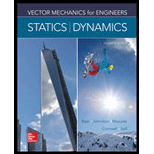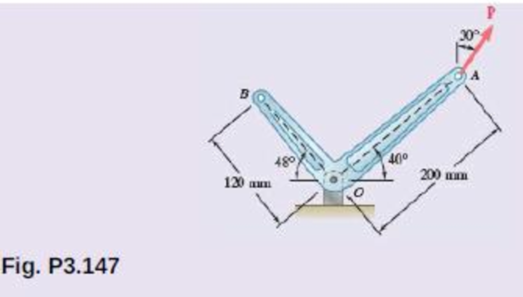
A 300-N force P is applied at point A of the bell crank shown. (a) Compute the moment of the force P about O by resolving it into horizontal and vertical components. (b) Using the result of part a, determine the perpendicular distance from O to the line of action of P.

(a)
The moment of the force P about O
Answer to Problem 3.147RP
The magnitude of the moment is about O is 20.5 N⋅m_.
Explanation of Solution
The magnitude of P is 300 N.
Write the expression for the vector from O to A.
rOA=200 mm(1 m1000 mm)cos40° ˆi+200 mm(1 m1000 mm)sin40° ˆj=(0.153209 ˆi+0.128558 ˆj) m (I)
Here rOA is the vector from O to A.
Write the expression for the force vector F.
F=300 N(sin30°) ˆi+300 N(cos30°) ˆj=(150 N) ˆi+(259.81 N) ˆj (II)
Write the expression for the moment at O.
MO=(rOA×F)
Here MO is the moment at O.
Conclusion:
Substitute (I) and (II) in the above equation to calculate MO.
MO=(0.153209 ˆi+0.128558 ˆj) m×(150 N ˆi+259.81 N ˆj)=(39.805 ˆk−19.2837 ˆk) N⋅m=(20.521 N⋅m) ˆk=20.5 N⋅m
Thus, the magnitude of moment at O is 20.5 N⋅m_.
(b)
The perpendicular distance from the point O to P.
Answer to Problem 3.147RP
The perpendicular distance from the point O to P is 68.3 mm_.
Explanation of Solution
The magnitude of moment at O is 20.5 N⋅m.
Write the expression to calculate the perpendicular distance from the point O to force P.
Fd=MO
Here d is the perpendicular distance, F is the magnitude of force P and MO is the magnitude of the moment.
Conclusion:
Substitute 300 N for P and 20.5 N⋅m for MO in the above equation to calculate d.
(300 N)d=20.5 N⋅md=20.5 N⋅m300 N=0.0683 m(1000 mm1 m)=68.3 mm
Thus, the perpendicular distance from the point O to P is 68.3 mm_.
Want to see more full solutions like this?
Chapter 3 Solutions
Vector Mechanics for Engineers: Statics and Dynamics
- 7.4 Impeller viscometer The rheology of a Penicillium chrysogenum broth is examined using an impeller viscometer. The density of the cell suspension is approximately 1000 kg m³. Samples of broth are stirred under laminar conditions using a Rushton turbine of diameter 4 cm in a glass beaker of diameter 15 cm. The average shear rate generated by the impeller is greater than the stirrer speed by a factor of about 10.2. When the stirrer shaft is attached to a device for measuring torque and rotational speed, the following results are recorded. Stirrer speed (s¹) Torque (Nm) 0.185 3.57 × 10-6 0.163 3.45 × 10-6 0.126 3.31 x 10-6 0.111 3.20×10-6 Can the rheology be described using a power-law model? If so, evaluate K and n.arrow_forward(read image)arrow_forward(read image) Answer Providedarrow_forward
- This is part B Part A's question and answer was find moment of inertia (Ix = 3.90×10^5) and radius of gyration (kx = 21.861) Determine the centroid ( x & y ) of the I-section, Calculate the moment of inertia of the section about itscentroidal x & y axes. How or why is this result different fromthe result of a previous problem?arrow_forwardDetermine by direct integration the moment of inertia of theshaded area of figure with respect to the y axis shownarrow_forwardConsider the feedback controlled blending system shown below, which is designed to keep theoutlet concentration constant despite potential variations in the stream 1 composition. The density of all streamsis 920 kg/m3. At the nominal steady state, the flow rates of streams 1 and 2 are 950 and 425 kg/min,respectively, the liquid level in the tank is 1.3 m, the incoming mass fractions are x1 = 0.27, x2 = 0.54. Noticethe overflow line, indicating that the liquid level remains constant (i.e. any change in total inlet flow ratetranslates immediately to the same change in the outlet flow rate). You may assume the stream 1 flowrate andthe stream 2 composition are both constant. Use minutes as the time unit throughout this problem. Identify any controlled variable(s) (CVs), manipulated variable(s) (MVs),and disturbance variable(s) (DVs) in this problem. For each, explain how you know that’show it is classified.CVs: ___________, MVs: _____________, DVs: ______________ b) Draw a block diagram…arrow_forward
- A heat transfer experiment is conducted on two identical spheres which are initially at the same temperature. The spheres are cooled by placing them in a channel. The fluid velocity in the channel is non-uniform, having a profile as shown. Which sphere cools off more rapidly? Explain. V 1arrow_forwardMy ID# 016948724 last 2 ID# 24 Last 3 ID# 724 Please help to find the correct answer for this problem using my ID# first write le line of action and then help me to find the forces {fx= , fy= mz= and for the last find the moment of inertial about the show x and y axes please show how to solve step by steparrow_forwardMy ID# 016948724 last 2 ID# 24 Last 3 ID# 724 Please help to find the correct answer for this problem using my ID# first write le line of action and then help me to find the forces and the tension {fx= , fy= mz=arrow_forward
- My ID# 016948724 last 2 ID# 24 Last 3 ID# 724 Please help to find the correct answer for this problem using my ID# first write le line of action and then help me to find the forces {fx= , fy= mz=arrow_forwardmy ID is 016948724 Last 2 ID# 24 Last 3 ID# 724 please help me to solve this problem step by step show me how to solve first wirte the line actions and then find the forces {fx=, fy=, mz= and for the last step find the support reactions and find forcesarrow_forwardUppgift 1 (9p) 3 m 3 m 3 m 3 m H G F 3 m ↑ Dy D B AAY 30° 8 kN Ay Fackverket i figuren ovan är belastat med en punktlast. Bestäm normalkraften i stängerna BC, BG och FG.arrow_forward
 International Edition---engineering Mechanics: St...Mechanical EngineeringISBN:9781305501607Author:Andrew Pytel And Jaan KiusalaasPublisher:CENGAGE L
International Edition---engineering Mechanics: St...Mechanical EngineeringISBN:9781305501607Author:Andrew Pytel And Jaan KiusalaasPublisher:CENGAGE L
